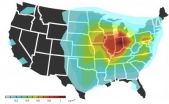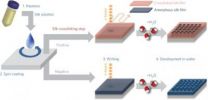(Press-News.org) Physicians have long suspected that chemotherapy can accelerate the aging process in patients treated for cancer. Using a test developed at UNC Lineberger Comprehensive Cancer Center to determine molecular aging, UNC oncologists have directly measured the impact of anti-cancer chemotherapy drugs on biological aging.
Researchers measured the level of p16, a protein that causes cellular aging, in the blood of 33 women over the age of 50 who had undergone chemotherapy for curable breast cancer. Samples were taken for analysis of molecular age from patients before chemotherapy, immediately following chemotherapy and a year after therapy finished. The analysis showed that curative chemotherapy also caused an increase in a patient's molecular age that on average was equivalent to 15 years of normal aging. The same was true in a separate group of 176 breast cancer survivors who had received chemotherapy on average three and a half years prior.
The study, headed by Hanna Sanoff, MD, MPH, assistant professor with the UNC School of Medicine and member of UNC Lineberger, is published in this week's Journal of the National Cancer Institute. Dr. Sanoff said that the results indicate that the p16 test holds promise as a means of evaluating how chemotherapy will affect a patient's long-term health and survival and as a predictive biomarker for the long-term toxicity of chemotherapy.
"Our theory is that if you have an advanced molecular age to begin with, it will be harder for you to tolerate chemotherapy," said Dr. Sanoff. "We believe a high level of p16 before treatment could mean that a patient will have a harder time making new blood cells after each chemotherapy treatment, and therefore be at greater risk for anemia and infection during chemotherapy."
The key role of p16 in human aging has been established over the last decade in the lab of UNC Lineberger Director Dr. Norman Sharpless. Research conducted in Sharpless' lab showed in 2004 that the levels of p16 increase exponentially with aging, and developed the p16 blood test for human use in 2009.
The next direction for this research, ongoing under the leadership of Dr. Hyman Muss, director of UNC Lineberger's Geriatric Oncology Program, involves determining if markers of molecular age predict patients' physical function and outcome in a number of clinical settings.
"While these findings are highly provocative, we have much more to study and will have to verify in future trials how these changes in molecular aging affect long term survival," said Dr. Muss. "Adjuvant chemotherapy has dramatically improved breast cancer survival and pending further data, the results of our study should not effect adjuvant chemotherapy decisions."
The p16 test seems particularly well-suited as an aging marker for this purpose as it plays a causal role in biological aging, is strongly correlated with chronological aging, and increases exponentially in response to pro-aging stimuli. Dr. Sanoff said she believes the test has promise as the basis of a clinical tool allowing physicians to evaluate the degree to which a given treatment accelerates biological and physical aging.
INFORMATION:
This work was supported by the National Institutes of Health (grants K07CA106722 and AG024379); the Paul Glenn Foundation; the Burroughs Wellcome Fund; and the Breast Cancer Research Foundation. UNC holds a patent on the diagnostic test of molecular aging. Lead authors on the study have no personal financial stake in the commercialization of the test.
UNC researchers show cancer chemotherapy accelerates 'molecular aging'
2014-03-28
ELSE PRESS RELEASES FROM THIS DATE:
Drilling into the trends in genetics and epigenetics of aging and longevity
2014-03-28
Since the dawn of civilization people were searching for clues to longevity and trying to extend human lifespan. But only in the past two decades with the advances in genetic sequencing, epigenetic analysis, and increased government investments the area experienced rapid expansion in the knowledge base, allowing scientists to develop comprehensive models and theories of aging. And while there is still much disagreement among scientists, the evolutionary theories are dominating the field. These theories predicted existence of certain genes that provide selective advantage ...
Research clarifies health costs of air pollution from agriculture
2014-03-28
Ammonia pollution from agricultural sources poses larger health costs than previously estimated, according to NASA-funded research.
Harvard University researchers Fabien Paulot and Daniel Jacob used computer models including a NASA model of chemical reactions in the atmosphere to better represent how ammonia interacts in the atmosphere to form harmful particulate matter. The improved simulation helped the scientists narrow in on the estimated health costs from air pollution associated with food produced for export – a growing sector of agriculture and a source of trade ...
NIST issues final Joplin tornado report, begins effort to improve standards and codes
2014-03-28
The National Institute of Standards and Technology (NIST) has released the final report on its technical investigation into the impacts of the May 22, 2011, tornado that struck Joplin, Mo. The final report is strengthened by clarifications and supplemental text suggested by organizations and individuals from across the nation in response to the request for comments on the draft Joplin report, released Nov. 21, 2013.
The revisions did not alter the investigation team's major findings or its 16 recommendations, highlighted by NIST's call for nationally accepted standards ...
Whether they reduce fat or not, obesity programs lower kids' blood pressure
2014-03-28
BUFFALO, N.Y. – One of the serious health consequences of obesity is elevated blood pressure (BP), a particular problem in children because research has found that high BP in children usually follows them into adulthood, carrying with it a wide range of possible negative consequences.
Even modest elevations in the BP of adolescents, according to recent research, can pose cardiovascular problems later in life.
A systematic review and meta-analysis of published studies of the effect of child obesity intervention programs on blood pressure has found that whether such programs ...
Stigmas, once evolutionarily sound, are now bad health strategies
2014-03-28
Stigmatization may have once served to protect early humans from infectious diseases, but that strategy may do more harm than good for modern humans, according to Penn State researchers.
"The things that made stigmas a more functional strategy thousands of years ago rarely exist," said Rachel Smith, associate professor of communication arts and sciences and human development and family studies. "Now, it won't promote positive health behavior and, in many cases, it could actually make the situation worse."
Stigmatizing and ostracizing members stricken with infectious ...
Fabricating nanostructures with silk could make clean rooms green rooms
2014-03-28
MEDFORD/SOMERVILLE, MASS. -- Tufts University engineers have demonstrated that it is possible to generate nanostructures from silk in an environmentally friendly process that uses water as a developing agent and standard fabrication techniques. This approach provides a green alternative to the toxic materials commonly used in nanofabrication while delivering fabrication quality comparable to conventional synthetic polymers. Nanofabrication is at the heart of manufacture of semi-conductors and other electronic and photonic devices.
The paper describing this work, "All ...
Safety and immunogenicity of 2 doses of the HPV-16/18 AS04 adjuvanted vaccine Cervarix
2014-03-28
A recent study in the journal Human Vaccines & Immunotherapeutics, showed that two doses of the HPV-16/18 AS04-adjuvanted vaccine Cervarix (GlaxoSmithKline) are non-inferior to three-doses in the current schedule.
Since high coverage and compliance rates can be difficult to achieve with the current three-dose HPV vaccineregimen, several studies have looked at the possibility of reducing the number of doses. Proof-of-principle that a two-dose schedule can provide sufficient protection against cervical cancer came initially from a study performed in Costa Rica in 2011. ...
Repeated hUCB injections may improve prognosis of children with deadly inherited disorder
2014-03-28
Putnam Valley, NY. (Mar. 28 2014) – New insight has been gained into treating an inherited disorder that creates serious neurological and behavioral disabilities in children and usually leads to death in the teen years.
In a recent study into the effects of human umbilical cord blood mononuclear cells (hUCB MNCs) when they are injected to counter the symptoms and progression of Sanfilippo syndrome type III B (MPS III B), researchers found that repeated injections into laboratory mice modeled with the disorder had clear benefits for the mice receiving multiple injections ...
Rainbow-catching waveguide could revolutionize energy technologies
2014-03-28
BUFFALO, N.Y. – More efficient photovoltaic cells. Improved radar and stealth technology. A new way to recycle waste heat generated by machines into energy.
All may be possible due to breakthrough photonics research at the University at Buffalo.
The work, published March 28 in the journal Scientific Reports, explores the use of a nanoscale microchip component called a "multilayered waveguide taper array" that improves the chip's ability to trap and absorb light.
Unlike current chips, the waveguide tapers (the thimble-shaped structures above) slow and ultimately absorb ...
Gene may predict if further cancer treatments are needed
2014-03-28
DALLAS – March 28, 2014 – UT Southwestern Medical Center researchers are developing a new predictive tool that could help patients with breast cancer and certain lung cancers decide whether follow-up treatments are likely to help.
Dr. Jerry Shay, Vice Chairman and Professor of Cell Biology at UT Southwestern, led a three-year study on the effects of irradiation in a lung cancer-susceptible mouse model. When his team looked at gene expression changes in the mice, then applied them to humans with early stage cancer, the results revealed a breakdown of which patients have ...






